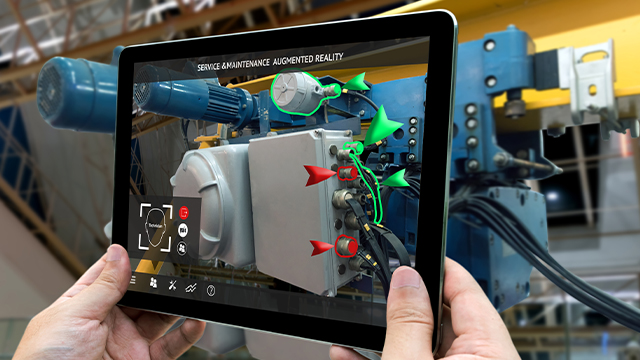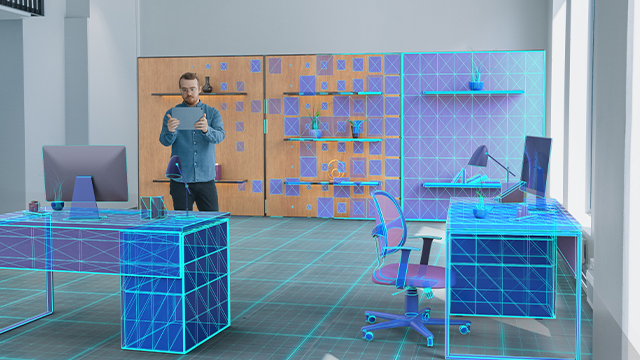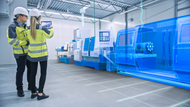Augmented Reality (AR) is a technology that is gaining popularity in various industries, and the field of Health, Safety, Environment and Quality (Health and Safety) is no exception. With its ability to merge virtual elements with real-world surroundings, AR has proven to be an effective tool for training employees in Health and Safety protocols.
Let's delve into the profound impact of AR on Health and Safety training, highlighting its benefits, applications, and the promising future it holds in this blog.
What is Augmented Reality (AR)?
Augmented Reality (AR) is an immersive technology that enriches our perception of reality by overlaying digital visual elements and graphics onto the physical world. Unlike Virtual Reality (VR), which constructs entirely artificial environments, AR seamlessly integrates virtual elements with our existing real-world environment, resulting in an immersive and interactive experience that amplifies our senses and enhances our understanding of the real and virtual worlds.
You can experience AR through an AR-enabled device, such as AR glasses, mobile devices, tablets, and other wearable technology. It has applications in various fields, such as gaming, education, navigation, medical training, interior design, and more. It bridges the gap between the physical and digital worlds, providing an interactive and immersive experience.
Augmented Reality (AR) in Health and Safety Training
Regarding Health and Safety training, workplaces can utilise AR to simulate mixed reality or virtual environments, providing employees hands-on experience without any actual risk. For example, workers can learn how to operate heavy machinery or handle hazardous materials in a virtual environment before doing it in real life, reducing the chances of accidents and injuries with real-world objects.

How is Augmented Reality (AR) Used in Health and Safety Training
- Safety Training: AR trains staff at all levels of an organisation, from field workers to managers. It provides a realistic and immersive experience that can improve understanding and retention of safety protocols and procedures.
- Healthcare Training: One example of AR in healthcare is in telemedicine services, where it is used to train unskilled users to perform ECG tests through interactive virtual simulations.
- Hazard Identification Training: AR headsets can display hazard signs to teach employees what to avoid on the job site while working. This real-time, on-site training can help prevent accidents and improve overall site safety.
- Firefighting Simulation: Virtual/Augmented reality allows employees to learn without putting them in potentially unsafe situations. For instance, during a firefighting simulation, employees can gain practical experience in a controlled, virtual environment.
- Training for Hazardous Environments: VR and AR training is particularly applicable to firms in industries that work heavily with highly hazardous materials. These technologies can simulate dangerous situations, allowing workers to gain exposure and learn how to respond without real-world risk.
Traditional Health and Safety training methods involve presentations, videos, or manuals. These methods are often monotonous and need to engage the trainees fully. On the other hand, AR makes training more interactive and engaging, leading to better retention of information.
Furthermore, trainers can customise training modules with AR according to specific job roles and scenarios. This allows for a personalised learning experience that caters to individual needs and abilities.

Benefits of Augmented Reality (AR) in Health and Safety Training Modules
Here are more of the key benefits of incorporating AR in Health and Safety training modules:
Efficient Information Processing
AR can help workers understand particular situations better. It provides a more immersive experience because trainees experience the hazard or situation more tangibly. This leads to more efficient information processing, improved memorisation, and the creation of better muscle memory.
On-Demand and Hands-Free Learning
The benefits of AR wearables for training include their ability to be on-demand, hands-free, and directly in the wearer's field of view. As a result, a worker can learn while performing tasks, leading to increased engagement and retention.
Improved Medical Training
AR-based learning modules provide anatomical visualisation and simulation, offering medical personnel a complete learning experience. This is particularly beneficial in healthcare training. AR allows visualising the body's interior organs, including their movements and functions. This makes understanding complex medical procedures much more accessible.
Realistic Simulations
AR provides the ability to create realistic simulations, which is particularly useful for training in hazardous environments. These simulations allow workers to gain exposure and learn how to respond without real-world risk.
Professional Immersion
AR training offers a heightened level of professional immersion by seamlessly blending real and virtual scenes, surpassing traditional training methods. This not only makes the training more engaging but also more effective. It also helps trainees to feel more confident and efficient in their work.
Pitfalls Faced During Augmented Reality (AR) Implementation for Health and Safety Training
AR implementation is not without its challenges, but its benefits to Health and Safety training make it worth considering. Here, we'll explore some common pitfalls faced during AR implementation in Health and Safety training.
1. Cost Constraints
One of the initial hurdles in AR adoption is the cost associated with hardware, software development, and training. Outfitting an entire workforce with AR devices can be a significant financial investment.
2. Integration with Existing Systems
Many organisations already have established Health and Safety training systems in place. Integrating AR seamlessly into these systems can be complex, requiring compatibility with existing software and data.Conduct thorough compatibility assessments and seek software solutions that offer integration options. Collaboration between IT teams and Health and Safety specialists is crucial to ensure a smooth transition.
3. Technical Expertise
AR implementation demands technical expertise to develop and maintain the required software and hardware. Finding and training skilled personnel can be a challenge. Invest in training programs or consider outsourcing AR development to specialised firms. Collaborate with experts who have experience in both AR technology and Health and Safety training.
4. User Adoption and Training
Introducing AR to a workforce unfamiliar with the technology can meet resistance or slow adoption rates. Develop comprehensive training programs that cater to users of all skill levels. Highlight the practical advantages of AR in Health and Safety training to motivate employees to embrace the technology.
5. Content Creation
Developing engaging and effective AR content for Health and Safety training can be time-consuming and require a creative approach. Collaborate with subject matter experts to create content that addresses specific training needs. Utilise AR development tools and templates to streamline content creation processes.
6. Data Privacy and Security
Data privacy and security are paramount, especially in industries with strict regulatory requirements. AR training involves collecting and storing sensitive data, making proper security measures critical. Ensure compliance with privacy regulations and implement secure storage and transfer protocols. Regular audits and security assessments are essential.
7. Maintenance and Updates
AR systems require ongoing maintenance and updates to remain effective. Neglecting these can lead to technical issues and outdated content. Establish a dedicated team or service contract to ensure regular maintenance and updates. Keep track of advancements in AR technology to stay current.
8. Resistance to Change
Some employees may resist the introduction of AR due to fear of job displacement or a preference for traditional training methods. Communicate the benefits of AR clearly, emphasising its role as a complement to, not a replacement for, existing training methods.

Utilising Safety Documents in AR Implementation During Health and Safety Training
Safety documents are vital in implementing augmented reality (AR) in Health and Safety training. They can provide crucial information and guidelines on how to use AR technology effectively for safety training. Here's how they help:
- Reference Material: Safety documents can also serve as reference materials, which AR can improve. For instance, manual or product maintenance guides could be enhanced with AR to provide interactive, step-by-step guidance.
- Training Modules: The documents can be used to develop AR training modules. These modules can cover various topics, from handling hazardous materials to operating complex machinery.
- Risk Management: Safety documents outline potential risks in the workplace. By incorporating these risks into AR training, employees can practice responding to them in a safe, virtual environment.
- Regulation Compliance: Safety documents ensure that AR training programs adhere to health and safety regulations. This compliance is crucial in industries such as construction, where non-compliance can result in severe penalties.
Where to Find Safety Documents for AR Implementation?
You can find safety documents helpful in implementing AR for Health and Safety training in various sources. SafetyDocs by SafetyCulture is Australia's leading source of safety compliance documents. It features many templates, checklists, and forms you can customise to meet your needs. We offer a range of safety document templates in various industries, including construction, manufacturing, and healthcare.
You can start with the following documents to get your AR implementation on track:
- Training Policy
- Competency, Training & Awareness Plan
- Checklists, Forms & Registers
- Policies and Procedures
These documents help you start and provide a solid foundation for AR implementation in Health and Safety training. Also, consult with your organisation's safety team to ensure that all relevant safety policies and procedures are included.
Future of AR in Health and Safety Training
With advancements in AR technology, we can expect to see even more realistic simulations that will provide trainees with near-real-life experiences. Moreover, AI and machine learning algorithms can make AR-based training modules more adaptive and personalised. This technology can also facilitate remote training, making it accessible to employees in different locations.
With the continuous advancement of technology, the potential of augmented reality (AR) in enhancing safety training is set to expand further.. Partner it with the appropriate safety documents, and you have a powerful tool for improving Health and Safety training in the workplace. Invest in AR technology and safety documents today to provide your employees with top-notch training that they can rely on.
Contact SafetyDocs today to learn more about our comprehensive range of safety documents and how they can support the implementation of AR in Health and Safety training. Let us help you make your workplace safer with augmented reality technology and compliance.
Our team of experts is dedicated to providing accurate and informative content. Craig Cruickshank, our senior HSEQ advisor at SafetyDocs by SafetyCulture has reviewed this blog post to ensure the highest level of quality.
Learn more about Craig's work on LinkedIn for more industry insights.
Available for instant download and supplied in fully editable MS Word format for use in your business.
Please note that the above information is provided as a comment only and should not be relied on as professional, legal or financial advice.
Share This Article
